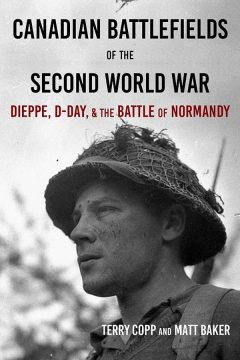In the village of Authie, France, population 1,500, it’s still possible to score a $56 hotel room with a nearby McDonald’s rated “catastrophique” on TripAdvisor. There is also a Rue des Canadiens “where the bodies of two murdered soldiers were placed on the street so that a tank could repeatedly run over them,” explains Canadian Battlefields Of The Second World War. In Authie in 1944 “wildly excited Hitler Youth began murdering Canadians while the battle still raged and continued killing prisoners systematically after the fighting ceased.” Murder victims numbered 37.
Authors Terry Copp and Matt Baker lead readers on an intriguing tour of the Normandy countryside that witnessed gallantry and atrocity. Take a drive down Highway D170, “one of the prettiest roads you will explore in Normandy,” they write. “This is one of the roads the Regina Rifles used in their advance inland on D-Day.” Names of the dead are immortalized in a village church.
Canadian Battlefields rises to the best tradition of war tour guides, juxtaposing tips on where to find a good, cheap lunch with concise accounts of horrific sacrifice where Canadians fought and died in “the hope of a better world.” The historical research is flawless; accompanying maps are compelling. Readers learn the actual location of parachute drop zones off the farm roads.
“The Canadian citizen army that fought in the Battle of Normandy played a role all out of proportion to its relative strength among the Allied armies,” the authors write: “Perhaps it is time to recognize the extraordinary achievements that marked the progress of the Canadians across Normandy’s fields of fire.”
“No one knew what the outcome of individual battles would be or how long the campaigns in Western Europe might last,” they note. “And no one knew exactly what was required of them.”
Readers are swept along the stony beach at Dieppe where 901 Canadians perished and 1,946 were taken prisoner in 1942. “The heroism of individuals could only accomplish minor miracles,” says Canadian Battlefields.
Only seven of 23 landing craft made it ashore that morning. Victims included tank crews drowned within sight of the beach. Canadian Battlefields takes readers through the seaside resort along a narrow lane to a nearby cemetery “beautifully kept,” it says.
And there is the village of Bretteville-sur-Laize, where the French erected a memorial to Private Gérard Doré of Roberval, Que., a veteran of the Fusiliers Mont-Royal. Doré enlisted at 15 and was dead at 16, “believed to be the youngest Canadian soldier killed in Normandy.” The marker reads: “Volunteer.”
By Holly Doan
Canadian Battlefields of the Second World War: Dieppe, D-Day and the Battle of Normandy, by Terry Copp and Matt Baker; Wilfrid Laurier University Press; 250 pages; ISBN 9781-92680-41701; $24








